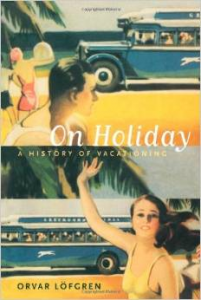 Ever wonder how the travel industry decides how to best take your money? To those of us here at WoWasis, it’s a fascinating topic. It’s not just about how that industry markets to us, either. It’s making sure that we like our vacation experiences enough that we’ll do it again and tell all our friends about it.
Ever wonder how the travel industry decides how to best take your money? To those of us here at WoWasis, it’s a fascinating topic. It’s not just about how that industry markets to us, either. It’s making sure that we like our vacation experiences enough that we’ll do it again and tell all our friends about it.
Author Orvar Lofgren exposes a lot about these topics in his fascinating On Holiday: A History of Vacationing (1999, ISBN 0-520-21767-5). There’s a lot of interesting categorization in the book, but two facets that keep popping up are travelers who like a little (or a lot) of adventure, with a certain amount of predictability, and those who want to relax and just not to have to think about anything beyond which pre-planned meal or event they’re going to next. As its title indicates, it’s a history book, but there’s lots to think about along the way. He covers everything from cottage vacations to resorts to cruises, waxing on the term “picturesque” as the foundation for most holiday stays and travel. There’s also the concept of “imagined nostalgia,” where you learn to miss the things you never had. Think in terms of sunsets and palm trees, and you get part of the picture.
Lofgren’s a good researcher and makes liberal use of thought-inspiring quotes from other writers, such as this one from writer Cleveland Amory on the evolution of the individual grand resorts:
Today’s resort old-timers believe firmly in a curious theory of resorts.
This theory is that, generally speaking, the following groups have come
to the social resorts in this order: first, artists and writers in search of
good scenery and solitude; second, professors and clergymen and other
so-called “solid people” with long vacations in search of the simple life;
third, “nice millionaires” in search of a good place for their children to
lead the simple life (as lived by the “solid people”); fourth, “naughty
millionaires” who wished to associate socially with the “nice million-
aires” but who built million-dollar cottages and million-dollar clubs,
dressed up for dinner, gave balls and utterly destroyed the simple life,
and fifth, trouble.
Small wonder that many art communities soon become unaffordable to artists. One of the more thought-provoking passages describes the packaging of today’s resorts, which now must combine a theme park, shopping mall, multimedia show, and hotel. For American major league baseball fans who complain that the jumbotron sound system is so loud that they can no longer talk to the person next to them, just look to Las Vegas. That’s the model being used in major league parks right now. It’s a 9 inning son-et-lumière experience. Baseball is merely the theme that supports the in-park shopping mall and the multimedia show, full of bombastically loud advertising.
 Finally, the author investigates the changes brought to native towns and villages that become destinations for world travelers. Beaches are taken over by hotels, the native population makes a good living, and visitors are exotic curiosities. But when the destination is no longer “hot,” the hotels close, restaurants and shops go broke and jobs dry up. And the questions linger. Has our paradise been destroyed? Was it worth it? Where (if anywhere) do we go from here?
Finally, the author investigates the changes brought to native towns and villages that become destinations for world travelers. Beaches are taken over by hotels, the native population makes a good living, and visitors are exotic curiosities. But when the destination is no longer “hot,” the hotels close, restaurants and shops go broke and jobs dry up. And the questions linger. Has our paradise been destroyed? Was it worth it? Where (if anywhere) do we go from here?
This book will cause every reader to linger over the history of vacationing, pause to reflect on its impact, and reflect on their own travel plans. The book’s a sleeper, well-documented and fascinatingly written. Highly recommended. Buy this book now at the WoWasis eStore.
Leave a Reply